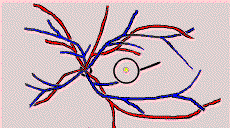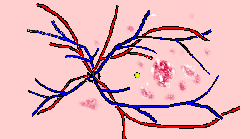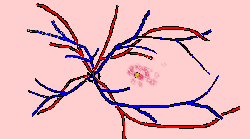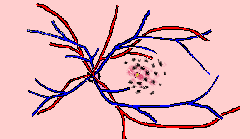|
| |
Maculopathy
The macula is the central area of your retina. It is
responsible for all your sharp vision, such as used for watching TV or reading.
It can become damaged in diabetes, usually with leaks developing. These can be lasered
successfully, as described below. Unfortunately laser does
not always stop damage developing, and your sight may beome affected. Generally this a
progressive condition, with more severe disease gradually developing as described below.
Laser is the only real treatment (but see Prevention). |
 This
is the view of your eye a doctor sees looking, just like a map. The central area of
the retina is the 'macula', shown by the black ring. Light focuses here, so any damage may
affect your sight. The very central area, the yellow dot, is the the fovea. |
| 
Side view of the eye:
light enters the eye from the left and focuses on the macula, the central area of
the retina. Damage to the macula affects your sight. |
 The leaks in the macular area can be sealed with laser
treatment. This is an animation (view on a computer... it does not show in a print out) |
Early Maculopathy
| Areas of leakage develop in retina, and the retina can
become boggy like a sponge. The leak can continue and get bigger, causing more and more
damage. Laser treatment can seal the leak and prevent it going on to cause more damage. Laser is a very bright light that is very focused so it makes tiny burns on
the retina. The burns are so tiny they cause very little damage when treating this type of
maculopathy. Once again, controlling your blood pressure, sugar, and fat levels (PREVENTION OF RETINOPATHY) can help to stop this condition
getting worse. Laser for this type of retinopathy is not painful.
Sometimes the leak needs more than one laser treatment. More often
than not more leaks develop over the next few years, again needing laser, as below. |

A small area of leakage developing in
the macula, near to the central area, as indicated by the black pointer. Laser is needed
to prevent the leakage spreading out, like a growing tree trunk.
CSME is the term given to describe
waterlogging of the macular area. It means 'clinicaly significant macular oedema'. Most
patients with CSME need laser. Your ophthalmogist can see this by examining your eye on a
'slit lamp' in the clinic.
Sometimes in the very early stages it is difficult to decide whether laser
will help. Your ophthalmologist makes tiny little burns with the laser in and around the
leaky area. |
Moderate Maculopathy
| As leaky areas develop, they need to be
lasered, otherwise the condition will become severe (Severe Maculopathy). The waterlogging
takes 4-6 months to disappear. Because of this, you will not know whether the treatment
has been successful until then. As long as the very centre of
the macular area remains healthy, the fovea, your vision will remain good. |

Moderate maculopathy: your sight would
be good as the centre... the yellow spot in this picture.. remains healthy. |
Diffuse Maculopathy
| Here the waterlogging affects
the very central of your vision, and will affect your sight. In the very early stages your
sight may be good, but usually, without laser, the leakage increases and your sight will
be reduced so reading and watching TV may become more difficult. |

The very centre of the vision can be
affected (the tiny yellow spot in the previous diagrams just above).

A 'C' pattern of laser is often
applied as above (shown in black). |
Severe maculopathy
| Your sight can be badly affected. Your
doctors will have tried to have prevented this severe condition developing, but sometimes
this is not possible even with the best treatment. As medicine
advances we hope fewer and fewer people will reach this stage.
Laser may help to seal leaky areas, but sometimes the tiny
capillaries are permanently damaged and laser does not restore your sight. (This process
is described in Retinopathy, Mechanisms.)
Please see Coping with Poor Vision if this has happened to you. |

These is condsiderable waterlogging in
the central area of the retina, and your vision may be very poor. |
|